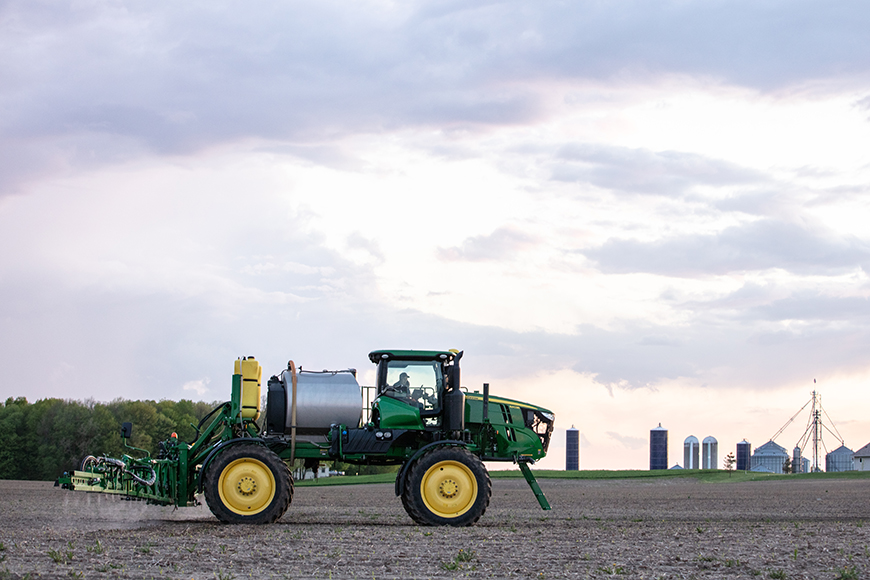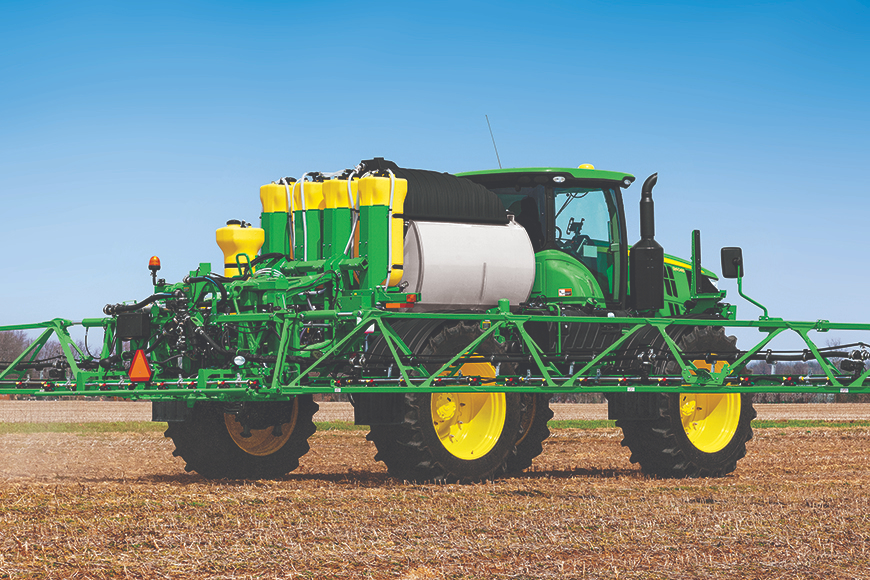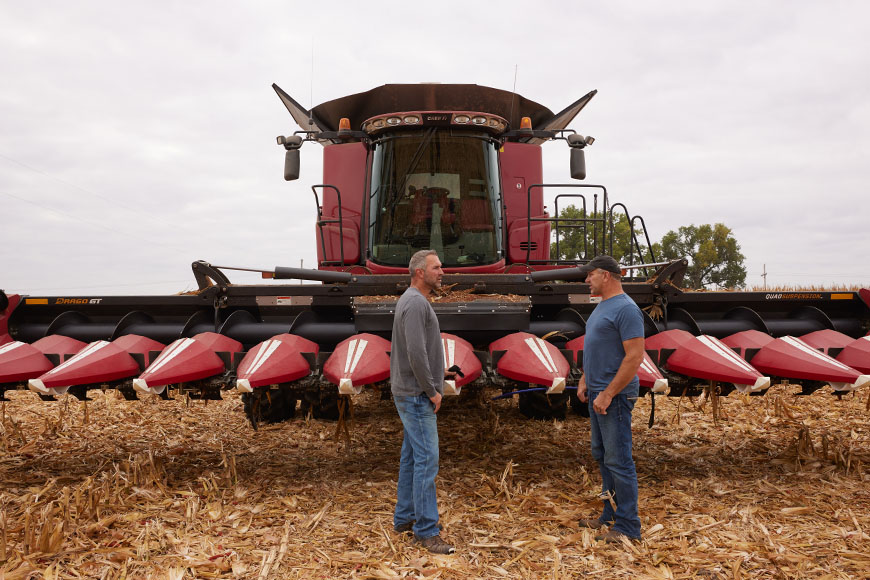3 Ways To Maximize Enlist® Herbicide Applications

The Enlist® weed control system is a popular choice for soybean growers. Enlist E3® soybeans have herbicide tolerance to 2,4-D choline, glyphosate and glufosinate, offering excellent flexibility for weed control programs.
Managing Enlist E3 acres yourself this season? Let’s walk through the most important elements for you to consider.
Warm-season annual weeds like waterhemp on the other hand need to be managed differently. These weeds don’t start emerging until after typical spring burndown or early-season postemergence timing. For these weeds, you’ll need to plan a mid-season application around late June, which means you may want to consider coupling Enlist with glufosinate.
Your program all depends on your weed spectrum. Stay on top of how your Enlist applications plug into those weed growth timings to maximize the potential effectiveness.
a. Spring burndown application.
If you’re facing winter annual weeds, it’s smart to apply a spring burndown. In the Enlist system, this tank mix likely contains Enlist One along with a burndown component plus a water conditioner. An MSO oil adjuvant is also critical for this application since you’ll likely be spraying it in cooler temperatures.
b. First post-emergence application.
A popular tank mix for the first post-emergence application is Enlist One plus glyphosate. A water conditioner plus a drift and deposition aid are important adjuvants to include in this pass. If you need volunteer corn control as well, you can add in a product like Section® Three herbicide. If you do this, it’s important to include an oil adjuvant.
With a product like StrikeLock® adjuvant , you can get both your drift control and oil component in one. Just be sure to include an oil adjuvant and increase your rate of Section Three by 33% to overcome antagonism with 2,4-D. To make this application even better, you can also add in a Group 15 herbicide for in-season residual control.
c. Second post-emergence application.
At this point, typically around late June, you’re probably targeting waterhemp and other warm-season annuals. For this application, Enlist One plus glufosinate is a great option. Again, for adjuvants, a water conditioner plus drift and deposition aid will be important to include. Double check how much ammonium sulfate (AMS) is required to apply with glufosinate in your area. That can change depending on geography.
With the Enlist system, the three most important adjuvant classes are water conditioners, drift and deposition aids and oils.
a. Water Conditioner
The most important adjuvant to include with Enlist One herbicide is a water conditioner because it is a weak acid herbicide. My top water conditioner recommendation is Class Act® NG® adjuvant. It contains AMS, which is the gold standard for maximizing Enlist One effectiveness. It also contains a surfactant and CornSorb® technology to help the droplets stick and spread better.
When you’re applying Enlist One, you’re probably mixing it with glyphosate or glufosinate, which are also both weak acid herbicides that respond to AMS. Class Act NG adjuvant helps improve the performance of all the post-emergence herbicides you would use in the Enlist program, including volunteer corn herbicides like Section Three. Class Act NG adjuvant is my universal, baseline recommendation for Enlist One tank mixes.
b. Drift & Deposition Aid
The Enlist system requires extra coarse droplets, which are bigger than you would normally run with flat fan nozzles. This makes it important to include an adjuvant that will help improve deposition. Adjuvants like InterLock®, MasterLock® and StrikeLock are all excellent at reducing drift and improving deposition. The more droplets you can get to the plant, sticking to the leaf and spreading across the surface, the better performance you’ll get from your herbicide.
c. Oil
Oil adjuvants like Superb® HC, Destiny® HC and StrikeLock also offer beneficial impacts to Enlist tank mixes. Most notably, they help improve performance under adverse weather conditions, whether it’s warmer and dryer than optimal or cooler and wetter. StrikeLock adjuvant is an especially great option because you get the drift and deposition benefits along with the oil component. When you include volunteer corn killer, you need oil anyway. When you include an oil, you’re not only helping 2,4-D uptake, you’re also helping to improve volunteer corn herbicide uptake if you’ve decided to include that in your application too.
At the end of the day, when I think about a really great Enlist adjuvant package, it’s a baseline of Class Act NG plus StrikeLock adjuvant.
Enlist E3 soybeans hold great performance potential. These recommendations will help you achieve more successful weed control so you can get more from your genetic investment. To further refine your management plan, contact your local WinField United retailer.
All photos are either the property of WinField United or used with permission.
© 2023 WinField United. Important: Before use always read and follow label instructions. Crop performance is dependent on several factors many of which are beyond the control of WinField United, including without limitation, soil type, pest pressures, agronomic practices and weather conditions. Growers are encouraged to consider data from multiple locations, over multiple years and to be mindful of how such agronomic conditions could impact results. Class Act, CornSorb, Destiny, InterLock, NG, MasterLock, StrikeLock, Superb and WinField are trademarks of WinField United. All other trademarks are the property of their respective owners
Managing Enlist E3 acres yourself this season? Let’s walk through the most important elements for you to consider.
1. Evaluate Your Weed Spectrum
The first step is evaluating your weed spectrum. Different weeds emerge at different times, so you need to know what you’ll need to target when. Winter annual weeds like marestail emerge in the fall or early in the spring and need to be controlled early in the season. For the Enlist system, it is important to have a strong and timely burndown or early-season post-emergence application to control these weeds.Warm-season annual weeds like waterhemp on the other hand need to be managed differently. These weeds don’t start emerging until after typical spring burndown or early-season postemergence timing. For these weeds, you’ll need to plan a mid-season application around late June, which means you may want to consider coupling Enlist with glufosinate.
Your program all depends on your weed spectrum. Stay on top of how your Enlist applications plug into those weed growth timings to maximize the potential effectiveness.
2. Set Your Herbicide Timing
Once you know your weed spectrum, you can start thinking about when you’ll apply Enlist and with which tank-mix partners. Here are a few examples:a. Spring burndown application.
If you’re facing winter annual weeds, it’s smart to apply a spring burndown. In the Enlist system, this tank mix likely contains Enlist One along with a burndown component plus a water conditioner. An MSO oil adjuvant is also critical for this application since you’ll likely be spraying it in cooler temperatures.
b. First post-emergence application.
A popular tank mix for the first post-emergence application is Enlist One plus glyphosate. A water conditioner plus a drift and deposition aid are important adjuvants to include in this pass. If you need volunteer corn control as well, you can add in a product like Section® Three herbicide. If you do this, it’s important to include an oil adjuvant.
With a product like StrikeLock® adjuvant , you can get both your drift control and oil component in one. Just be sure to include an oil adjuvant and increase your rate of Section Three by 33% to overcome antagonism with 2,4-D. To make this application even better, you can also add in a Group 15 herbicide for in-season residual control.
c. Second post-emergence application.
At this point, typically around late June, you’re probably targeting waterhemp and other warm-season annuals. For this application, Enlist One plus glufosinate is a great option. Again, for adjuvants, a water conditioner plus drift and deposition aid will be important to include. Double check how much ammonium sulfate (AMS) is required to apply with glufosinate in your area. That can change depending on geography.
3. Choose Your Adjuvant Package
With weed spectrum identified and herbicide timing set, it’s time to lock in your specific adjuvants. Some growers still underestimate the impact a quality adjuvant can make on their program’s performance, but it’s a critical component for maximizing herbicide investment. If you use a lower quality adjuvant, you welcome more risk that the herbicide may not perform as expected, especially if facing adverse weather conditions.With the Enlist system, the three most important adjuvant classes are water conditioners, drift and deposition aids and oils.
a. Water Conditioner
The most important adjuvant to include with Enlist One herbicide is a water conditioner because it is a weak acid herbicide. My top water conditioner recommendation is Class Act® NG® adjuvant. It contains AMS, which is the gold standard for maximizing Enlist One effectiveness. It also contains a surfactant and CornSorb® technology to help the droplets stick and spread better.
When you’re applying Enlist One, you’re probably mixing it with glyphosate or glufosinate, which are also both weak acid herbicides that respond to AMS. Class Act NG adjuvant helps improve the performance of all the post-emergence herbicides you would use in the Enlist program, including volunteer corn herbicides like Section Three. Class Act NG adjuvant is my universal, baseline recommendation for Enlist One tank mixes.
b. Drift & Deposition Aid
The Enlist system requires extra coarse droplets, which are bigger than you would normally run with flat fan nozzles. This makes it important to include an adjuvant that will help improve deposition. Adjuvants like InterLock®, MasterLock® and StrikeLock are all excellent at reducing drift and improving deposition. The more droplets you can get to the plant, sticking to the leaf and spreading across the surface, the better performance you’ll get from your herbicide.
c. Oil
Oil adjuvants like Superb® HC, Destiny® HC and StrikeLock also offer beneficial impacts to Enlist tank mixes. Most notably, they help improve performance under adverse weather conditions, whether it’s warmer and dryer than optimal or cooler and wetter. StrikeLock adjuvant is an especially great option because you get the drift and deposition benefits along with the oil component. When you include volunteer corn killer, you need oil anyway. When you include an oil, you’re not only helping 2,4-D uptake, you’re also helping to improve volunteer corn herbicide uptake if you’ve decided to include that in your application too.
At the end of the day, when I think about a really great Enlist adjuvant package, it’s a baseline of Class Act NG plus StrikeLock adjuvant.
Enlist E3 soybeans hold great performance potential. These recommendations will help you achieve more successful weed control so you can get more from your genetic investment. To further refine your management plan, contact your local WinField United retailer.
All photos are either the property of WinField United or used with permission.
© 2023 WinField United. Important: Before use always read and follow label instructions. Crop performance is dependent on several factors many of which are beyond the control of WinField United, including without limitation, soil type, pest pressures, agronomic practices and weather conditions. Growers are encouraged to consider data from multiple locations, over multiple years and to be mindful of how such agronomic conditions could impact results. Class Act, CornSorb, Destiny, InterLock, NG, MasterLock, StrikeLock, Superb and WinField are trademarks of WinField United. All other trademarks are the property of their respective owners






.jpeg?ext=.jpeg)